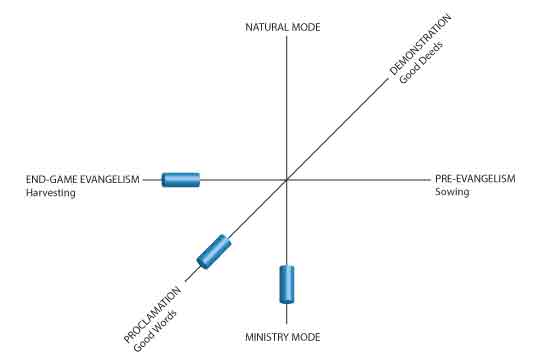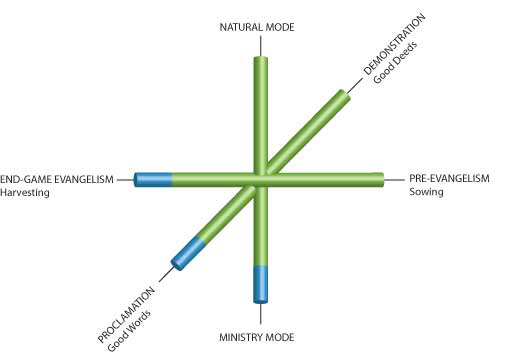Analysis and Proposals
Throughout our research, a picture emerged that explains why our staff feel ineffective and dissatisfied in evangelism. In brief, there is incongruence between the behavior they feel trained for and expected to perform, and the behavior they feel would be most helpful to the majority of the lost on their campuses.
The college campus has changed. As it has, the skills that an effective evangelist must possess have also changed. However, our staff have not kept up with these changes, nor have they felt the freedom to do so.
Our rich culture and great historical success in evangelism have caused us to see particular modes and methods of evangelism as primary for our staff and students. However, our staff, unbelievers, new believers, outside experts, and the books we read are all telling us one thing: more comprehensive skill-sets and approaches in evangelism are required.
Consider the following chart, which represents three different continuums of evangelistic skills:
Along the X-axis (horizontal) are dialogic skills. To the left (End-Game Evangelism) are skills helpful in explaining the essence of the gospel to someone who is potentially ready to believe. To the right (Pre-Evangelism) are skills an evangelist would need to explain the gospel to someone whose worldview is incompatible with belief in the gospel. We have historically been a 
harvesting organization and our staff are well equipped to explain substitutionary atonement to people with a worldview to accept it. We are much less skilled at graciously deconstructing worldviews of those who are not ready.
The Y-axis (vertical) represents the skills useful in ministry mode and natural mode evangelism. Our evangelism model embraces both, but in our training and skills we lean heavily toward ministry mode.
The Z-axis suggests the skills useful in proclaiming and demonstrating the gospel, or as we termed it elsewhere in this report, Good Words and Good Deeds. Good Words are to the fore, and Good Deeds, to the back. As we all know, we 
have focused primarily on proclamation (Good Words) and our skills reside there.
All the skills represented at every point along each axis are valuable, but some skills will find greater usefulness based on the needs of the culture. Indeed, it’s likely that we developed our current expertise in the lower, left, front quadrant specifically because of the needs of the culture at the time of our founding (and through our early years).
However, as the culture has changed, the skills needed to effectively reach it have changed as well. Over the years the number of students ready to believe the gospel has shrunk. Some still exist, and our traditional skills will be very helpful to them. However, since we are tasked to reach every student (the blue and the green), we need skills to reach every student, including the green majority who are not yet ready to respond in faith to Christ.
This means we must broaden our capacities to play (and win) at both sides of all three axes. We need to continue to excel in proclaiming the essence of the gospel in ministry mode contexts to those ready to believe. But we also need to learn a whole new set of skills that will help us move Unbelievers toward readiness. We need to learn how to combine Good Deeds with our Good Words, address incompatible worldviews, and function comfortably in natural mode contexts.
Fortunately, the seeds for what we are proposing already exist within our organization. These seeds need to be watered and fertilized so they can come to maturity in the form of improved skill-sets and a new balance in our approaches to evangelism.
With great respect to our heritage and hope for our future, we recommend the following steps be taken:
1. Affirm Permission to Sow
From the highest levels of our Mid-Atlantic Leadership (and hopefully in conjunction with our National Leadership), we must repeatedly articulate authentic permission to be involved in pre-evangelistic/sowing activities. From speaking with our leadership, we believe staff do have this permission, but they aren’t experiencing it. Our rich heritage, the stories we tell, the metrics we count, and the experiences of Big Break and Summer Projects all speak more loudly than the permission that has been expressed. Our staff need to be persuaded that sowing activities will be regarded as meaningful and valid by their leadership.
2. Adjust the Paradigms
While our evangelism model values ministry, natural, and body modes of evangelism, our default posture tends toward ministry mode. For instance, though CoJourners demonstrates organizational approval of natural mode, many staff and students continue to experience evangelism as an activity performed with strangers. We need to champion new paradigms of reaching the collegians of the Mid-Atlantic (and US) by helping Christians reach those closest to them: their friends and classmates.
We know that CCC is famous for crossing barriers into new places, but the truth is that few of our students are even reaching those who sit next to them in class. Given that people who come to Christ do so overwhelmingly in the context of relationships, we need to emphasize reaching those with whom we have the greatest opportunities for influence as we move toward reaching every collegian in our Mid-Atlantic (and US) scope.
3. Assist with Compassion
We should require some type of compassionate activity among our movements at their local address. We are encouraged by the energy being given to this already (e.g. GAiN & one million meals for Haiti at Big Break), but we have a way to go to touch our local movements. For the health of our own hearts, for our perceived image on our campuses, and for the simple fact that Jesus did this, we need to develop expertise in this non-traditional focus. As we grow in demonstrating the love of God, we expect more opportunities to express the love of God.
4. Accelerate Transferability
Part of the genius of Campus Crusade for Christ is our focus on transferability. We must apply that expertise in developing approaches, tools, and training to help our staff and student leaders develop the skills needed to sow and deconstruct/reconstruct worldviews. We have some tools for this, but we need more and better resources to equip students in these complex tasks.
5. Align the Metrics
Metrics must be amended to value pre-evangelistic and sowing activities described above. We believe there is value in motivating, celebrating, and monitoring evangelistic activity that takes place throughout a movement. We must count what both staff and students do across the full range of desirable evangelistic behavior. This measuring can help us to emphasize and value what will most help the lost.
6. Aspire to Dependence
Finally, our intuition says that even if we do all of these things successfully, we are destined for failure apart from an outpouring of God’s Spirit on our campuses. Therefore, we ought to afford ourselves every opportunity to raise up a presence of prayer to the Living God, to thaw the hearts of this generation of collegians and depend on him daily. Unless the Lord builds this house, we labor in vain.
To read other people’s comments or enter your own please click here.

